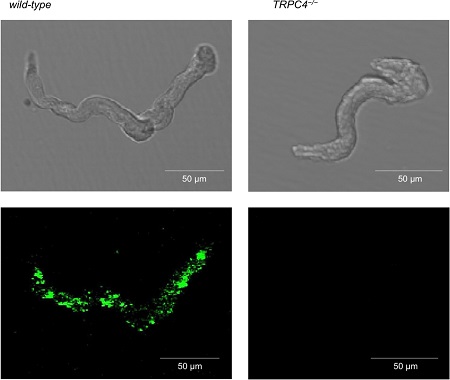Overview
- Peptide (C)KEKHAHEEDSSIDYDL, corresponding to amino acid residues 943-958 of mouse TRPC4 (Accession Q9QUQ5). Intracellular, C-terminus.
- Rat brain membranes (1:200-1:500). Human PC3 and LNCaP cells.
 Western blot analysis of rat brain membranes:1. Anti-TRPC4 Antibody (#ACC-018), (1:200).
Western blot analysis of rat brain membranes:1. Anti-TRPC4 Antibody (#ACC-018), (1:200).
2. Anti-TRPC4 Antibody, preincubated with TRPC4 Blocking Peptide (#BLP-CC018). Western blot analysis of human PC3 Caucasian prostate adenocarcinoma (lanes 1 and 3) and human LNCaP prostate carcinoma (lanes 2 and 4) cell lysates:1,3. Anti-TRPC4 Antibody (#ACC-018), (1:200).
Western blot analysis of human PC3 Caucasian prostate adenocarcinoma (lanes 1 and 3) and human LNCaP prostate carcinoma (lanes 2 and 4) cell lysates:1,3. Anti-TRPC4 Antibody (#ACC-018), (1:200).
2,4. Anti-TRPC4 Antibody, preincubated with TRPC4 Blocking Peptide (#BLP-CC018).
- Rat brain lysates.
- Mouse brain sections.
- Rat type I astrocytes (1:25) (Grimaldi, M. et al. (2003) J. Neurosci. 23, 4737.).
Human U373 MG cells (1:100) (Barajas, M. et al. (2008) J. Neurosci. Res. 86, 3456.).
The Transient Receptor Potential (TRP) superfamily is one of the largest ion channel families and consists of diverse groups of proteins. In mammals, about 28 genes encode the TRP ion channel subunits. The mammalian TRP superfamily comprises six subfamilies known as the TRPC (canonical), TRPV (vanilloid), TRPM (melastatin), TRPML (mucolipins), TRPP (polycystin) and the TRPA (ANKTM1) ion channels.1-4
The TRPC subfamily consists of seven proteins named TRPC1 to 7 which can be further divided into four subgroups based on their sequence homology and functional similarities:
1. TRPC1
2. TRPC4 and TRPC5
3. TRPC3, TRPC6, TRPC7
4. TRPC2.2,5
They are highly expressed in the central nervous system and to a lesser extent in peripheral tissues.
TRPC4 can form heterotetramers with TRPC1. TRPC4, TRPC1 and TRPC5 can be activated either by calcium store depletion or by GPCR stimulation pathways and are also assumed to form components of store operated channels in some cell types such as salivary gland cells, endothelial cells and vascular smooth muscle cells. 6
Application key:
Species reactivity key:

Knockout validation of Anti-TRPC4 Antibody in mouse smooth muscle cells.Immunocytochemical staining of mouse smooth muscle cells with Anti-TRPC4 Antibody (#ACC-018). TRPC4 staining is prominent in wild type cells (left panels). TRPC4 is not detected in TRPC4-/- cells (right panels) demonstrating the specificity of the antibody.Adapted from Griffin, C.S. et al. (2018) Sci. Rep. 8, 9264. with permission of SPRINGER NATURE.
